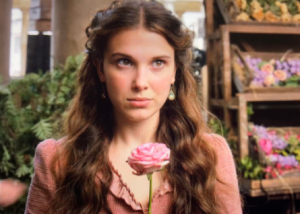Are Disney Princesses Bad Role Models?

Are Disney princesses bad role-models for little girls?
September 12, 2016
From the time girls turn five, they dream of becoming Disney princesses. They have posters of Ariel on bedroom walls. They walk around with lunchpails and backpacks adorned with Disney princesses. They dress up as Elsa for Halloween. So why wouldn’t they dream of actually being one? After all, they all “lived happily, ever after.” Is there one Disney princess story where the protagonist doesn’t win? Whether it’s Rapunzel , a damsel in distress, or Mulan , a female warrior, their enemy is always defeated, and the princess lives happily ever after with her dashing prince. But are the Disney movies providing a positive image for little girls to imitate?
To begin, the Disney characters are almost always beautiful. Think of every Disney princess movie you’ve ever watched, and name one protagonist that isn’t good-looking. The Disney prince or princess never has a flaw, which puts an unrealistic image of beauty in viewers’ minds. Aside from wicked witches and evil stepmothers, which character isn’t beautiful? Jasmine, Ariel, Cinderella, and Snow White, are all gorgeous. Even the Beast, in Beauty and the Beast, after changing back from his monstrous state, becomes a dashing prince. Nobody is flawless, so Disney shouldn’t make all of its characters unrealistically perfect. Because of these beautiful characters, many people have the mindset that they should have a perfect body. Little girls idolize these characters at a young age, which leads to body image issues later.
Another common theme in Disney movies is a damsel in distress. In many princess movies, like “Snow White and the Seven Dwarfs”, “Sleeping Beauty”, “Cinderella”, and “The Little Mermaid”, the man saves the princess, while the women are needy and helpless. This creates an illusion that girls needs to be saved by a prince, rather than be independent, and raises an expectation that women need to be taken care of. This condition is even called Cinderella Complex after the Disney princess Cinderella. However, the idea that women are cared for by men is contrary to many American households. In many homes, both the husband and wife work and are completely self-sufficient, and in some others, the wife provides for an entire family. This expectation must change; after all, we nominated Hillary Clinton to lead our country as our first female president. Show me a Disney princess who is a scientist or inventor, in a day and age when most STEM careers are filled with men, (Science, Technology, Engineering and Mathematics). It would be nice to have a Disney figure that lures girls into taking these subjects.
And, before I finish, I just want to say that I’m not referring to all Disney movies. I understand that not all princess films are like this. In fact, recently, Disney has been changing. Now, Disney producers are identifying these problems in their movies, and are changing their approach on the traditional princess movie. Mulan portrays a traditionally male role, and saves scores of people, Anna saves her kingdom of Arendelle, and Pocahontas is the only princess who doesn’t end up with the boyfriend. But even in these movies, there is a dashing prince who saves the princess from peril. Disney movies still incorporate these elements, and portray these negative messages. So, I’m not saying not to watch Disney movies, but to take their lessons with a grain of salt. Don’t try to mimic or idolize these princesses, because Disney characters aren’t the best role models.





